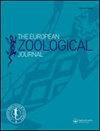Environmental features drive lineage diversification in the Aricidea assimilis species complex (Annelida, Paraonidae) in the Mediterranean Sea
IF 1.6
4区 生物学
Q2 ZOOLOGY
引用次数: 2
Abstract
Abstract Individuals identified as Aricidea assimilis Tebble, 1959 were collected from ten localities across the Mediterranean Sea from 0.5 to 225 m depth in order to have a wide coverage of the species habitats and geographic range and to assess the effects of environmental factors and biogeographical barriers on molecular and morphological diversity. Two mitochondrial and one nuclear markers were used to reconstruct phylogenetic relationships and test the occurrence of cryptic species. We observed two highly divergent lineages, one including all individuals from shallow, sandy environments (<10 m depth) and the other with the individuals from deeper muddy bottoms (30–225 m depth). Less pronounced divergence was detected between morphologically distinct brackish-water individuals and the remaining shallow-water individuals. The divergence observed between deep-water and shallow-water lineages is consistent with the hypothesis of distinct species. The ambiguous results of species delimitation tests applied to the two shallow-water sub-lineages might instead suggest a process of incipient speciation, even if this hypothesis needs additional evidence. These results suggest that sediment represents the main factor driving genetic divergence and ultimately cryptic speciation in A. assimilis, while other depth-associated factors and geographical barriers do not seem to significantly contribute to the genetic architecture of this species, suggesting the occurrence of wide-range larval dispersal.环境特征驱动地中海拟合拟合拟合拟合拟合拟合拟合拟合拟合拟合拟合拟合拟合拟合拟合拟合拟合拟合拟合拟合
摘要从地中海0.5至225米深度的十个地点采集了1959年被鉴定为Aricida assimilis Tebble的个体,以广泛覆盖物种栖息地和地理范围,并评估环境因素和生物地理屏障对分子和形态多样性的影响。使用两个线粒体和一个核标记重建系统发育关系,并测试隐物种的发生。我们观察到两个高度分化的谱系,一个包括所有来自浅层沙质环境(深度<10米)的个体,另一个包括来自更深泥底(深度30-225米)的个人。在形态上不同的微咸水个体和剩余的浅水个体之间检测到不太明显的差异。深水和浅水谱系之间观察到的差异与不同物种的假设一致。应用于这两个浅水亚系的物种划界测试的模糊结果可能反而表明了一个早期物种形成的过程,即使这一假设需要额外的证据。这些结果表明,沉积物是驱动A.assimilis遗传分化和最终隐蔽物种形成的主要因素,而其他深度相关因素和地理障碍似乎对该物种的遗传结构没有显著影响,这表明幼虫传播范围很广。
本文章由计算机程序翻译,如有差异,请以英文原文为准。
求助全文
约1分钟内获得全文
求助全文
来源期刊

European Zoological Journal
Agricultural and Biological Sciences-Animal Science and Zoology
CiteScore
3.10
自引率
5.60%
发文量
80
审稿时长
30 weeks
期刊介绍:
The European Zoological Journal (previously Italian Journal of Zoology) is an open access journal devoted to the study of all aspects of basic, comparative and applied protozoan and animal biology at molecular, cellular, tissue, organ, organismal, population, and community-ecosystem level. Papers covering multiple levels of organization and integrative approaches to study animal form, function, development, ecology, evolution and systematics are welcome. First established in 1930 under the name of Il Bollettino di Zoologia, the journal now has an international focus, reflected through its global editorial board, and wide author and readership.
 求助内容:
求助内容: 应助结果提醒方式:
应助结果提醒方式:


